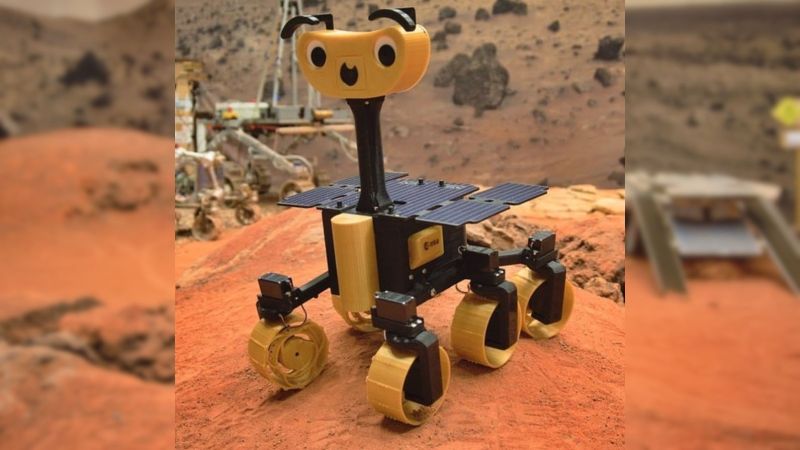Over the past few weeks, a new season of Mars fever kicked off with launches of three interplanetary missions. And since there’s a sizable overlap between fans of spaceflight and those of electronics and 3D printing, the European Space Agency released the ExoMy rover for those who want to experience a little bit of Mars from home.
ExoMy’s smiling face and cartoonish proportions are an adaptation of ESA’s Rosalind Franklin (formerly the ExoMars) rover which, if 2020 hadn’t turned out to be 2020, would have been on its way to Mars as well. While Rosalind Franklin must wait for the next Mars launch window, we can launch ExoMy missions to our homes now. Like the real ESA rover, ExoMy has a triple bogie suspension design distinctly different from the rocker-bogie design used by NASA JPL’s rover family. Steering all six wheels rather than just four, ExoMy has maneuvering chops visible in a short Instagram video clip (also embedded after the break).
ExoMy’s quoted price of admission is in the range of 250-500€. Perusing instructions posted on GitHub, we see an electronics nervous system built around a Raspberry Pi. Its published software stack is configured for human remote control, but as it is already running ROS (Robot Operating System), it should be an easy on-ramp for ExoMars builders with the ambition of adding autonomy.
ExoMy joins the ranks of open source rover designs available to hackers with 3D printing, electronics, and software skills. We recently covered a much larger rover project modeled after Curiosity. Two years ago NASA JPL released an open source rover of their own targeting educators, inspiring this writer’s own Sawppy rover project, which is in turn just one of many projects tagged “Rover” on Hackaday.io. Hackers love rovers!
















I think it’d be a good idea to send a fleet of smaller rovers, each one dedicated to running a single type of experiment in addition to a common sensor suite of cameras, temperature sensors etc. For Mars that suite could also include a speaker and microphone with the ability to be configured with software as a wide area SONAR. Why use sound in the thin Martian atmosphere? For gathering more data.
Testing audio propagation of the thin atmosphere at various distances and temperatures can provide additional data above what a simple barometer or pressure and temperature sensors can provide. If put on an arm so the sound transducer and microphone can be placed in direct contact with the surface, the audio propagation can tell something about the subsurface before disturbing it by digging. Could be used to avoid large rocks that would impede digging, possibly discover subsurface ice or frozen CO2.
And of course these small rovers should all be equipped with a fan to blow dust off their solar panels. Fans could also be used to suck up samples and blow lose material off places for instruments to be used for testing and grinding samples off rocks. The same method used to avoid rocks for digging could be used to find rocks for sampling.
No, not a fan. They should play lout metal through the speakers and mosh to shake the dust off. There would be synergy, the dust probably has some iron oxide in it and that’s metal.
Hey Roger!
Miro, one ExoMy developer from ESA here. :)
Thanks for this great article covering ExoMy! We’re looking very much forward to see more of your newest Sawppy Mini iteration. Looks really great so far.
Cheers from the Netherlands
Very happy to see it using ROS, finally some sanity in there :P
Number 5 alive!